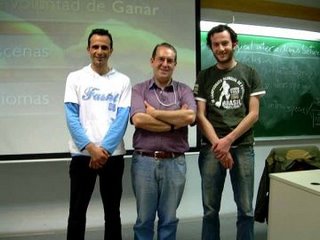For the occasion of the recent publication in the magazine Nature of the discovery of a skull of a hominid in Ethiopia belonging to a child of three years, whose antiquity is soared to 3,3 million before the present, Eudald Carbonell and Carlos Lorenzo, members of the team of research of Atapuerca, value the transcendence of this discovery. For the authors, in its ensemble this skull provides basic data for the study of the human evolution and the different adaptations that has entailed
This article was published in the journal El Mundo the 21st of September
The Language of our ancestors
EUDALD CARBONELL Y CARLOS LORENZO
The team directed by the Ethiopian scientist Zeresenay Alemseged has published in Nature the discovery of a skull and other remains of the same skeleton of a hominid who died when he had 3 years. This skeleton found in the region of Dikika, in
In the first place, the discovery of infantile or young individuals of our ancestors allows to know how it was the development and the growth of the hominids 3 million years ago. On occasions the young individuals do not have the same characteristics as the bones of the adult individuals. For example, in the bones of the legs of this skeleton adaptations to the biped locomotion can already be observed. However, in his arms he preserves some primitive characteristics that allowed him to climb up the trees with skill. This combination of characteristics has also been observed in the adult individuals of Australopithecus afarensis, but the interpretation of these features keeps being the object of debate.
Some scientists think that these singularity constitute the evidence of a type of semi-arborescent life, for others they only represent evolutionary heredity that these hominids still preserved. This new skeleton can help to clarify the type of locomotion of the first hominids and which were the first " steps" in the acquisition of our straight posture.
But in our opinion in this study it is important to be highlighted that cleaning the inferior part of the skull of the same skeleton they have found a hyoid bone. This bone of the throat constitutes a key element to reconstruct the linguistic capacities of our ancestors. Up to the date the oldest hyoid that was known had 400.000 years of antiquity and proceeded from the Sima de los Huesos, in the famous highland of Atapuerca. In all the fossil record of the human evolution, another hyoid bone had only been found of one Neanderthal with 60.000 years of antiquity.
That is, the hyoid published now of Australopithecus afarensis constitutes a discovery of enormous importance. The form of this hyoid is very similar to that of the chimpanzees and gorillas and we can therefore say that the capacity to talk about the Australopithecus would be as those of the big apes. This basic feature of the human beings was acquired after the occurrence of our gender Homo, that is after the 2 million years. In fact, from the team of research of Atapuerca we have carried out different scientific publications where our opinion is that the linguistic capacities could rise something more than one a million years and all the species of Homo subsequent to this acquisition have a high degree of complexity.
